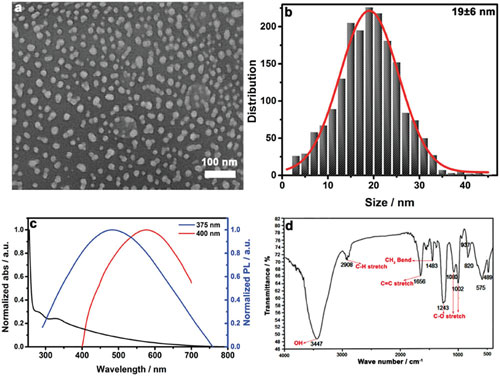| Posted: Jan 19, 2018 | |
Tuning perovskite solar cells with nanoparticle additives(Nanowerk News) Researchers have employed carbon nanoparticles with an average diameter of 20 nm in high efficiency state-of-the-art perovskite solar cells to control the morphology of the perovskite film. |
|
| Recently, perovskite solar cells have attracted considerable interest among the photovoltaics research community, because of their high solar-to-electric power conversion efficiencies and low fabrication costs. | |
| In new work, reported in Advanced Energy Materials ("Carbon Nanoparticles in High-Performance Perovskite Solar Cells"), an international research team has for the first time, carbon nanoparticles (CNPs) containing functional groups have been incorporated in perovskite solar cells. | |
 |
|
| Carbon nanoparticles. a) Top SEM image, b) size distribution curve, c) UV–vis absorbance and photoluminescence spectra of CNPs in DMF:DMSO 4:1 for 375 and 400 nm excitation wavelengths, and d) IR spectra of CNPs. (© Wiley-VCH Verlag) (click on image to enlarge) | |
| "we find that the functional groups of the CNPs interact with perovskite components already in the precursor solution resulting in a larger grain size, better thermal stability, and hydrophobicity of the perovskite film," write the scientists. "Whereas efficiencies above 18% could be maintained after adding the CNPs, the hysteresis in the current–voltage curves was considerably decreased compared to reference devices." | |
| The films show larger grain sizes and increased thermal stability when CNPs were added to the perovskite by dispersing them in the precursor solution. | |
| Whereas a power conversion efficiency larger than 18% could be maintained, the hysteresis was decreased to negligible values despite using a TiO2 contact. | |
 |
|
| Different perovskite solutions image and device schematic. a) CsM perovskite solution (left) and the CsM/0.08CNP solution (right), crosssectional SEM images of b) CsM and c) CsM/0.08CNP solar cells and d) schematic of full perovskite solar cell. (© Wiley-VCH Verlag) | |
| Films containing CNPs were found to be more hydrophobic. NMR analyses showed that hydrogen bonds are formed between formamidinium cations and functional groups of CNPs already in solution. | |
| "This study shows that additives are a promising path toward morphology tuning and increasing thermal stability," the authors conclude. |
 By
Michael
Berger
– Michael is author of three books by the Royal Society of Chemistry:
Nano-Society: Pushing the Boundaries of Technology,
Nanotechnology: The Future is Tiny, and
Nanoengineering: The Skills and Tools Making Technology Invisible
Copyright ©
Nanowerk LLC
By
Michael
Berger
– Michael is author of three books by the Royal Society of Chemistry:
Nano-Society: Pushing the Boundaries of Technology,
Nanotechnology: The Future is Tiny, and
Nanoengineering: The Skills and Tools Making Technology Invisible
Copyright ©
Nanowerk LLC
|
|
|
Subscribe to a free copy of one of our daily Nanowerk Newsletter Email Digests with a compilation of all of the day's news. |
